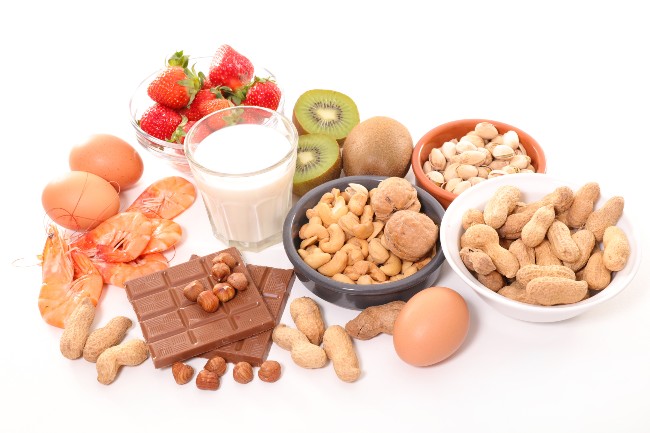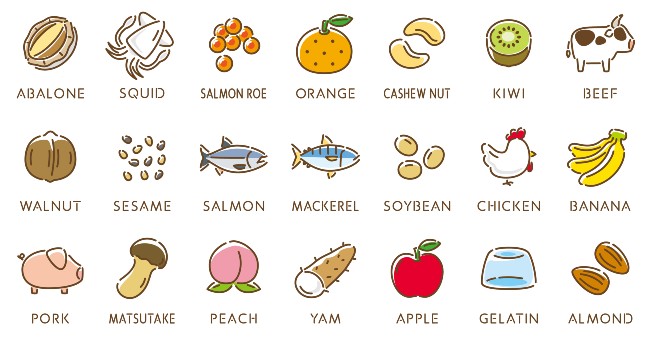Food Allergies in Japan: How to Read Japanese Food Labels

Japan has a diverse food culture that enjoys experimenting with a variety of ingredients with a strong emphasis on soy, wheat, fish, and shellfish. It just so happens that these four ingredients are included in the group of eight foods that account for 90 percent of all food-allergic reactions.
Allergens commonly found in Japanese foods
Needless to say, if you are allergic to any one of these ingredients be sure to have a firm understanding of their Japanese translations before arriving.
Fish and Shellfish
Japan is a very seafood oriented country. You will find seafood such as shrimp and other fish mixed in with everything from pizza to pastries.
Soy
Used in Japan’s most famous condiment soy sauce, this ingredient is added to many soups, such as ramen and miso soup, and used for many marinating sauces for items like fried chicken.
Wheat
This ingredient is used in soba noodles and a popular tea called Mugicha.
Required allergen listings on Japanese food labels

Food Allergens the big 7

It is always tricky going to a foreign country when you suffer from food allergies. What makes things worse is when the writing on the labels is unreadable. Luckily, the Ministry of Agriculture, Forestry, and Fishery (MAFF) in Japan has made a legal requirement that all manufacturers must indicate the following seven foods if they are included as ingredients:
Food Allergens 20 Items which are not always listed

If you didn’t notice, soy is not listed as one of the seven food ingredients. The MAFF created another list of twenty additional foods that they “recommend” manufacturers display on their products-which includes soybean. This means that manufacturers are not legally required to list soy as an ingredient on their label unless they feel the need to do so.
The complete list of twenty additional allergens is as follows:
Another hurdle for those suffering from allergic reactions is that component ingredients aren’t always listed if it is considered common knowledge that the ingredient includes a food allergen (e.g., mayonnaise, which is the listed ingredient, contains eggs). If you know how to read mayonnaise in Japanese this may not be as big of an issue. For those who can't however, this can create obvious difficulties when dealing with foreign foods and languages.
(By the way, mayonnaise written in Japanese is マヨネーズ.)
If you suffer from allergic reactions to any of the food items listed above be extra cautious and ask before eating, or completely ignore the item altogether if you have any concerns or hesitations.
Japanese food kanji and characters to know for allergies
If you have food allergies and are lucky, when buying or ordering food in Japan, the packaging or menu will have English or pictures identifying if any of the required seven foods are present. Unfortunately, it is more common that the ingredients are listed only in Japanese, so it is important to be able to recognize these items and their Japanese translations. You can often find this list of foods next to the Japanese spelling for allergy (アレルギー).

Also, if you need to tell someone you have an allergy, you can do so by referring to the list below along with the following phrase:
Food Allergens in Japanese
If you were allergic to peanuts, you would say, “Pi-natsu arerugî desu" (I'm allergic to peanuts).
| Allergen | Pronunciation | Kanji | Kana |
|---|---|---|---|
| Buckwheat | Soba | 蕎麦 | そば、ソバ |
| Crab | kani | 蟹 | かに、カニ |
| Egg | tamago | 卵 | たまご、タマゴ |
| Milk | gyu-nyu | 牛乳 | ぎゅうにゅう、ギュウニュウ |
| Peanut | pi-natsu | 落花生 | らっかせい、ラッカセイ, ピーナッツ |
| Shrimp | ebi | 海老 | えび、エビ |
| Wheat | komugi | 小麦 | こむぎ、コムギ |
Below you will find the common spelling for the other twenty suggested food allergens.
| Allergen | Pronunciation | Common Spelling |
|---|---|---|
| Abalone | awabi | あわび |
| Apple | ringo | りんご |
| Banana | banana | バナナ |
| Beef | gyu-niku | 牛肉 |
| Cashew nut | kashu-natsu | カシューナッツ |
| Chicken | tori-niku | 鶏肉 |
| Gelatin | zera-chin | ゼラチン |
| Kiwi | kiwi-furutsu | キウイワルーツ |
| Mackerel | saba | さば |
| Matsutake mushroom | matsutake | まつたけ |
| Orange | orenji | オレンジ |
| Peach | momo | もも |
| Pork | buta-niku | 豚肉 |
| Salmon | sake / shake | さけ |
| Salmon Roe | ikura | いくら |
| Sesame | goma | ゴマ |
| Soybean | daizu | 大豆 |
| Squid | ika | いか |
| Walnut | kurumi | くるみ |
| Yam or sweet potato | yama-imo | やまいも |
For those of you who like to make the most of technology, there is a free application available on most smartphones called Waygo Translator and Dictionary, which allows you to translate text through your smartphone camera, which can be helpful when trying to locate allergy labeling on packaging and menus. You can read about more useful apps in Japan on the best apps for living in Japan.
In case of an allergy related emergency while in Japan
In the event that immediate attention is necessary or an emergency, the first thing to do is call 119 for assistance. If you are in Tokyo, an English-speaking operator will be able to assist you, but outside of Tokyo it is important to learn how to request help in Japanese as it is unlikely that the operator will be able to understand foreign languages. Ask the operator to send an ambulance as soon as possible. Be ready to provide the operator with as much of the following information as possible: name, gender, age, address, description of location using landmarks, and the reason for immediate assistance.
For more information on medical care in Japan and how to find an English-speaking doctor in the Tokyo area, we suggest reading our article on medical care in Japan for English speakers.

- Rental Apartments & Houses in Tokyo
- Listings of popular and luxurious rental apartments, condominiums, and houses designed with expats in mind.

- Apartments & Houses for Sale in Tokyo
- Listings of apartments, condominiums, and houses available for purchase in Tokyo.




















